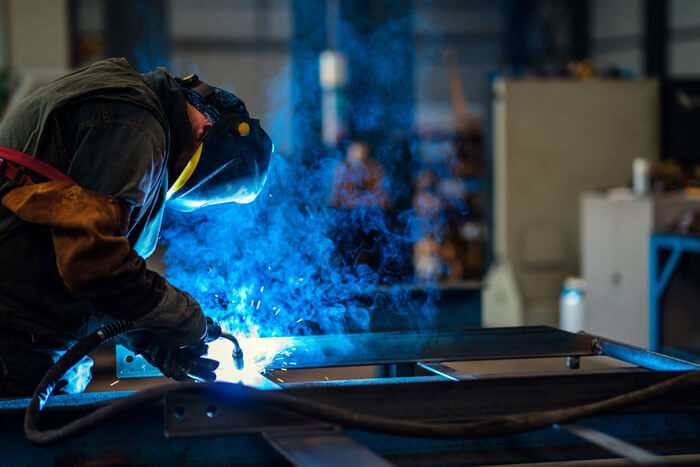Welding is found in many industries. It is a method of joining metal parts by melting the pieces and filling the joint with molten metal. This requires high temperatures of 3,000 - 25,000oC.
The high temperatures needed for welding results in many toxic materials being released into the air. The source of the toxic materials includes the base metals being welded, electrode metal, flux material, coatings, residues, oils, rust inhibitors, solvent- based paints, and primers on the base metal. This airborne mixture of materials is often referred to as “welding fume”, although only part of the emissions are truly fume. A true fume is as described below. The basic types of airborne emissions are:
- Fumes – These are mostly metals that evaporate from the high heat and then condense to form very small particles. Most of these particles come from the welding electrode and flux used.
- Smoke – Contaminants on the metal being welded such as grease, oils, paints, and other finishes release a hazardous soup of decomposition chemicals. These can include some of the more toxic metals such as lead, chromium, cadmium, plus isocyanates, chlorides, and phosgene.
- Gasses – Different gasses can be released depending on temperature and method of welding, such as:
- Ozone – UV light from an electric arc can oxidize oxygen to form ozone.
- Carbon monoxide – UV light from an electric arc can convert carbon dioxide in a shielding gas to carbon monoxide.
- Shield gasses – Helium, argon, or carbon dioxide.
- Fluorides – Fluorides in the flux can breakdown with heat to form gasses.
- Nitrogen oxides – Nitrogen in the air combines with oxygen to form nitrogen oxides.
- Flammable gasses – Fuel components such as acetylene or propane can be released.
- Physical hazards – in addition to the airborne emissions there are other hazards including noise and radiation such as UV light.
These are not just simple “welding fumes” that go with the job, they are toxic, preventable, and can have long-term health effects. Many of these materials have regulated exposure limits. Check with your local authority or Occupational Hygienist to determine what the local exposure limits are. The following is a summary of the hazards presented by the airborne components of “welding fume”:
- Metal fumes – Metal fumes are very small particles of metal. They are formed when the metals are heated above their melting point. They evaporate and then condense to form airborne particles. These very small particles can penetrate deep into the lungs where they are absorbed into the body. The fumes are a mixture of metals from aluminum to zinc, found in the base metals, the welding rod, and the flux. Most airborne metals are from the welding rod
There are many different exposure limits for welding fume. Some jurisdictions have welding fume standards of 1 – 8 mg/m3 based on the total amount of airborne fume. This standard does not take into account the different mixtures of metals that make up the fume, which have a wide range of toxicities. The toxicity of the welding fumes will vary depending on what metals are in the mixture. A more reliable method of estimating the toxicity is to measure the concentration of all the metals in the fume and use the individual exposure limits for each metal found. No metal should exceed its exposure limit.
It should be noted that many metals have similar toxic effects. Where two or more materials have the same effect on the same target organ, the effects are considered additive. In addition to the individual components not exceeding the occupational exposure limit, the additive effects should not exceed the allowable level. Examples of additive health effects of the metals found in typical welding fume include:
- Cancer
- Long-term organ toxicity
- Reproductive effects
- Damage to the Central Nervous System (other than narcosis)
- Respiratory sensitivity, asthma
- Cumulative lung disease
- Anemias
- Irritation
Your Occupational Hygienist can help measure the concentration of airborne contaminants and interpret the results.
- Smoke – Smoke is a mixture of solid and liquid particles, gasses, and vapours that are created by the incomplete combustion of organic matter such as greases, oils, paints, or other contaminants on the surface of the metals. Smoke can contain hundreds to thousands of different toxic chemicals. Smoke from burning plastics is particularly toxic. Like metal fumes, there is no occupational exposure limit for welding smoke, only for a small portion of the potential chemicals that could be generated.
- Ozone – Ozone is created when the ultraviolet (UV) light from arc welding converts oxygen in the air to ozone. Short exposures to ozone target the lungs causing pulmonary congestion, edema, and hemorrhage.
- Nitrogen oxides – Nitric oxide and nitrogen dioxide are formed by the combination of nitrogen and oxygen in air at the high temperatures found in welding. At lower levels they produce ocular, mucous membrane, and respiratory tract irritation. At higher levels, pulmonary edema can occur.
- Fluorides – These can be a mixture of different fluorides as the fluoride combines with metals and other materials in the fume. Fluorides can affect bone changes due to fluorosis as well as irritation of the eyes and respiratory tract. Welders have reported "sinus trouble" in areas where air tests indicated concentrations of fluoride below the occupational exposure limit.
As discussed above “welding fume” contains many chemicals that can cause short-term and long-term illnesses at very low exposure levels. The International Agency for Research on Cancer (IARC) has classified welding fumes as carcinogenic to humans (Group 1). This category is used when there is sufficient evidence of carcinogenicity in humans. However, there is good news - exposures can be controlled with good work practices, good equipment, improved ventilation, and appropriate respirators where required.
Interested in learning more about the authors?
Alison Reineke, BSc, CIH, ROH, CRSP
Alison is a Certified Industrial Hygienist (CIH), a Registered Occupational Hygienist (ROH), and a Canadian Registered Safety Professional (CRSP). She has conducted field investigations and inspections of various industries in order to evaluate and control exposure to harmful chemical agents such as welding fume, metals, solvents, asbestos, and noise. She currently teaches the OHS Hygiene Course in the Occupational Health & Safety Certificate Program at Red River College.
John Elias, MPH, CIH, ROH, CRSP, FAIHA
Over a 50+ year period, John has served as Head of Occupational Hygiene for the Province of Manitoba, as a corporate hygienist for a large hospital, and as an occupational hygiene consultant. During that time, he has helped management and workers achieve healthier workplaces. Welding safety and health was an issue in many of the industries. Over the last 50+ years, welding health and safety has been made more complex by not only changing health standards but also changing equipment, making welding an interesting and constantly changing challenge.
Christian McCormick CRSP, ROHT
Christian is an occupational hygienist working for Corporate Health Works Inc. He is currently working for numerous Manitoba-based companies assisting in evaluating and controlling exposure to welding fumes. He remains current with new developments and technologies that assist in improving air quality, contributing to a safer and healthier workplace.












